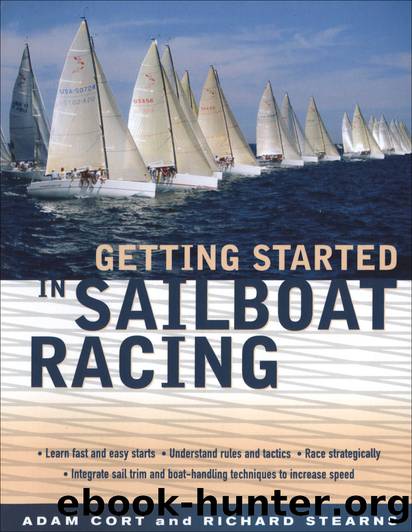Getting Started in Sailboat Racing by Adam Cort & Richard Stearns

Author:Adam Cort & Richard Stearns
Language: eng
Format: epub
Publisher: McGraw Hill LLC
Published: 2013-05-15T00:00:00+00:00
SMART PORT-STARBOARD CROSSING
All too often, especially for beginners, the success of a beat can boil down to a single port-starboard crossing. One moment youâre tearing along on port tack, executing your race strategy; the next, another boat on starboard tack appears as if out of nowhere, apparently on a collision course, and your entire crew is thrown into a panic. Everybody shouts out their opinion, but no one knows what to do. Maybe you throw in a crash tack at the last moment to avoid disaster. Maybe you bear off in a flurry of white water in order to pass astern. In either case you suddenly find yourself almost dead in the water. Everybody is flustered, frowning, no longer thinking ahead. The recriminations fly. Nobody is bothering to keep track of windshifts or boat speed anymore. Sailboat racing has suddenly become a whole lot less fun.
The real pity is all of this was unnecessary. Thereâs no reason why any single crossing situation should be a disaster. In fact, if you put the following principles into practice, the situation should not be a setback at all.
Be Aware. As noted in chapter 3, The Windward Leg, always keep an eye out for other boats. With forewarning there is seldom, if ever, a reason to panic. If you are sailing on a keelboat with a larger crew, make sure those sailors on the windward rail know theyâre more than just ballast: theyâre also your eyes and ears. In heavy air they should be looking ahead and to leeward, especially when youâre on port tack. Donât hesitate to send somebody to the low side every now and then to peek around the leech of the genoa and make sure there isnât anybody hiding on the other side of all that sailcloth. If someone is on the low side trimming the headsail, he or she should take a quick look around as a matter of course. Itâs also not a bad idea to have that crew take out the winch handle again after trimming, just in case. That way, if you do ever find yourself having to do a crash tack, at least youâll be able to get the jib sheet off.
In order to determine well ahead of time whether youâre going to pass ahead or behind a competitor in a crossing situation, check to see whether you are making land. In other words, try to determine who will pass ahead, based on how the other boat appears to be moving relative to the land or other objects in the area. For example, if the other boat appears to be moving forward relative to a stationary object behind it, it will pass ahead of you; if it appears to be slipping backward relative to its background, you will pass in front; and if it is stationary relative to the background, you are on a collision course. Another way of judging this is with a handheld compass. If your bearing on the other boat (or any other object, for that matter) is constant, you are on a collision course.
Download
This site does not store any files on its server. We only index and link to content provided by other sites. Please contact the content providers to delete copyright contents if any and email us, we'll remove relevant links or contents immediately.
The River by Peter Heller(2204)
Breath by James Nestor;(2193)
Deep by James Nestor(2109)
Fatal Storm by Rob Mundle(2106)
Sea Survival Handbook by Keith Colwell(2079)
Lonely Planet Australia by Lonely Planet(2000)
Iced In by Chris Turney(1901)
Discover Australia by Lonely Planet(1872)
Lonely Planet Maldives (Travel Guide) by Planet Lonely & Masters Tom(1765)
Looking for a Ship by John McPhee(1607)
One Girl One Dream by Dekker Laura(1597)
Ten Degrees of Reckoning: The True Story of a Family's Love and the Will to Survive by Hester Rumberg(1578)
Chicken Soup for the Ocean Lover's Soul by Jack Canfield(1574)
Lonely Planet Australia (Travel Guide) by Lonely Planet & Lonely Planet(1530)
South with the Sun by Lynne Cox(1488)
The Wave In Pursuit of the Rogues, Freaks and Giants of the Ocean(1450)
Diver Down by Michael Ange(1443)
Marlinspike Sailor's Arts and Crafts by Barbara Merry(1427)
The Golden Rules: 10 Steps to World-Class Excellence in Your Life and Work by Bob Bowman & Charles Butler(1406)
